Impact of Interest Rate Fluctuation on Commercial Banks in Tajikistan
78 Pages33590 Words89 Views
Added on 2023-01-23
About This Document
This dissertation focuses on analyzing the impact of interest rate fluctuation on commercial banks in Tajikistan after accession to the WTO. It examines the relationship between interest rate and commercial banks, analyzes the impact of interest rate liberalization in the financial system of Tajikistan, and compares Tajikistan's interest rate with its neighboring countries. The research aims to fill the research gap in understanding the fluctuation of interest rates and its effects on the banking industry in Tajikistan.
Impact of Interest Rate Fluctuation on Commercial Banks in Tajikistan
Added on 2023-01-23
ShareRelated Documents
Dissertation (Chapter 1,2, 3
Modification)
Modification)
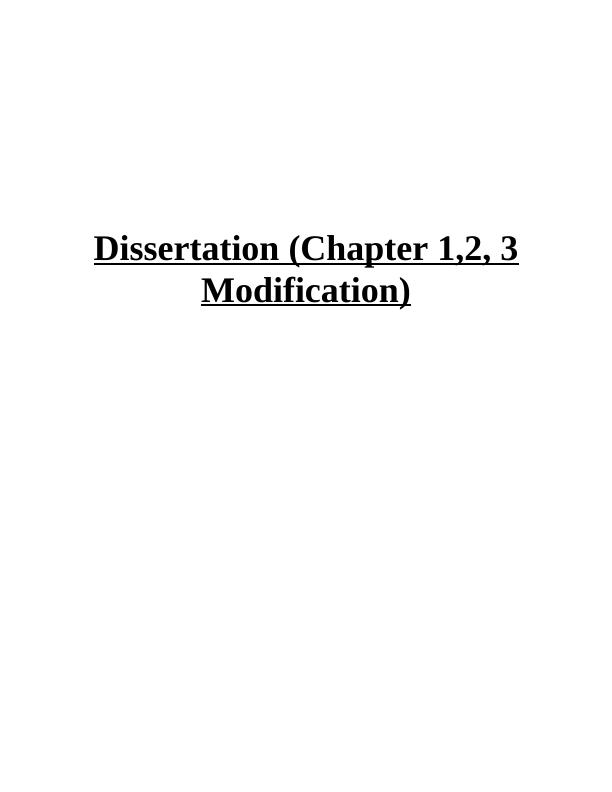
Table of Contents
CHAPTER 1 - INTRODUCTION...................................................................................................5
INTRODUCTION ..........................................................................................................................5
Background .................................................................................................................................5
Research Problem........................................................................................................................8
Aim& Objectives of the Research...............................................................................................8
Research Questions......................................................................................................................9
Research Hypothesis....................................................................................................................9
Justification for the Research.......................................................................................................9
Brief Description of the Research Methodology.........................................................................9
Outline of the Thesis..................................................................................................................10
terms...........................................................................................................................................10
Scope of the Research................................................................................................................12
Limitation of study.....................................................................................................................13
Theoretical background ............................................................................................................13
Chapter summary ......................................................................................................................14
CHAPTER 2: LITERATURE REVIEW.......................................................................................15
2.0 Introduction..........................................................................................................................15
2.1 Current condition of interest rate and associated theories with interest rate.......................15
2.1.1 Overview...........................................................................................................................15
2.1.2 Theory related to interest rate fluctuation.........................................................................15
2.1.3 International theory related to Interest rate fluctuation.....................................................16
2.1.4 Comparison of both theories.............................................................................................16
2.1.5 Condition of interest rate in commercial banks................................................................16
2.1.6 Impact of Interest rate fluctuation in Tajikistan................................................................19
2.2 Theory behind fluctuation of Interest Rates ........................................................................21
2.2.1 Background.......................................................................................................................21
2.2.2 Interest Rate Parity............................................................................................................21
2.2.2 Classical theory.................................................................................................................22
2.2.3 How both theory affect country........................................................................................23
2.2.4 Model behind used in order to know fluctuation of Interest Rates...................................25
CHAPTER 1 - INTRODUCTION...................................................................................................5
INTRODUCTION ..........................................................................................................................5
Background .................................................................................................................................5
Research Problem........................................................................................................................8
Aim& Objectives of the Research...............................................................................................8
Research Questions......................................................................................................................9
Research Hypothesis....................................................................................................................9
Justification for the Research.......................................................................................................9
Brief Description of the Research Methodology.........................................................................9
Outline of the Thesis..................................................................................................................10
terms...........................................................................................................................................10
Scope of the Research................................................................................................................12
Limitation of study.....................................................................................................................13
Theoretical background ............................................................................................................13
Chapter summary ......................................................................................................................14
CHAPTER 2: LITERATURE REVIEW.......................................................................................15
2.0 Introduction..........................................................................................................................15
2.1 Current condition of interest rate and associated theories with interest rate.......................15
2.1.1 Overview...........................................................................................................................15
2.1.2 Theory related to interest rate fluctuation.........................................................................15
2.1.3 International theory related to Interest rate fluctuation.....................................................16
2.1.4 Comparison of both theories.............................................................................................16
2.1.5 Condition of interest rate in commercial banks................................................................16
2.1.6 Impact of Interest rate fluctuation in Tajikistan................................................................19
2.2 Theory behind fluctuation of Interest Rates ........................................................................21
2.2.1 Background.......................................................................................................................21
2.2.2 Interest Rate Parity............................................................................................................21
2.2.2 Classical theory.................................................................................................................22
2.2.3 How both theory affect country........................................................................................23
2.2.4 Model behind used in order to know fluctuation of Interest Rates...................................25

2.2.5 Analysis of how fluctuation of interest rates took place...................................................26
2.2.6 Impact of Negative Interest Rates on implementation in different banks or financial
institutions in Tajikistan.............................................................................................................27
2.3 To analyse the impact of interest rate liberalisation in the financial system of Tajikistan.. 31
2.3.1 Briefing.............................................................................................................................31
2.3.2 Interest rate relaxation relationship with the financial system..........................................31
2.3.3 Relative factors behind the cause of fluctuation of interest rate.......................................38
2.4 Comparing the interest rate liberalization of Tajikistan with the neighbourhood countries42
2.4.1 Prelude..............................................................................................................................42
2.4.2 Interest rate liberalisation of Tajikistan with neighbouring countries..............................42
2.4.3 Benefits and challenges of accession to WTO in the banking sector of Tajikistan..........46
2.5 Limitation of the review framework address by the study..................................................53
2.6 Summary..............................................................................................................................53
CHAPTER 3: RESEARCH METHODOLOGY...........................................................................55
3.1 Theoretical paradigm and assumptions................................................................................55
3.1.1 Epistemology....................................................................................................................55
3.1.2 Ontology...........................................................................................................................55
3.1.3 Methodology.....................................................................................................................56
3.2 Selection of research methods.............................................................................................56
3.3 Research Philosophy............................................................................................................56
3.4 Research approach...............................................................................................................59
3.5 Pilot Study............................................................................................................................60
3.6 Research design, Strategy and Procedures...........................................................................61
3.7 Data Collection....................................................................................................................61
3.7.1 Primary Data Collection...................................................................................................62
3.7.1.1 Quantitative Questionnaire............................................................................................63
3.7.1.2 Qualitative Structure......................................................................................................63
3.7.2 Secondary Data.................................................................................................................64
3.8 Sampling..............................................................................................................................64
3.9 Ethical Considerations.........................................................................................................65
3.9.1 Informed consent..............................................................................................................65
2.2.6 Impact of Negative Interest Rates on implementation in different banks or financial
institutions in Tajikistan.............................................................................................................27
2.3 To analyse the impact of interest rate liberalisation in the financial system of Tajikistan.. 31
2.3.1 Briefing.............................................................................................................................31
2.3.2 Interest rate relaxation relationship with the financial system..........................................31
2.3.3 Relative factors behind the cause of fluctuation of interest rate.......................................38
2.4 Comparing the interest rate liberalization of Tajikistan with the neighbourhood countries42
2.4.1 Prelude..............................................................................................................................42
2.4.2 Interest rate liberalisation of Tajikistan with neighbouring countries..............................42
2.4.3 Benefits and challenges of accession to WTO in the banking sector of Tajikistan..........46
2.5 Limitation of the review framework address by the study..................................................53
2.6 Summary..............................................................................................................................53
CHAPTER 3: RESEARCH METHODOLOGY...........................................................................55
3.1 Theoretical paradigm and assumptions................................................................................55
3.1.1 Epistemology....................................................................................................................55
3.1.2 Ontology...........................................................................................................................55
3.1.3 Methodology.....................................................................................................................56
3.2 Selection of research methods.............................................................................................56
3.3 Research Philosophy............................................................................................................56
3.4 Research approach...............................................................................................................59
3.5 Pilot Study............................................................................................................................60
3.6 Research design, Strategy and Procedures...........................................................................61
3.7 Data Collection....................................................................................................................61
3.7.1 Primary Data Collection...................................................................................................62
3.7.1.1 Quantitative Questionnaire............................................................................................63
3.7.1.2 Qualitative Structure......................................................................................................63
3.7.2 Secondary Data.................................................................................................................64
3.8 Sampling..............................................................................................................................64
3.9 Ethical Considerations.........................................................................................................65
3.9.1 Informed consent..............................................................................................................65
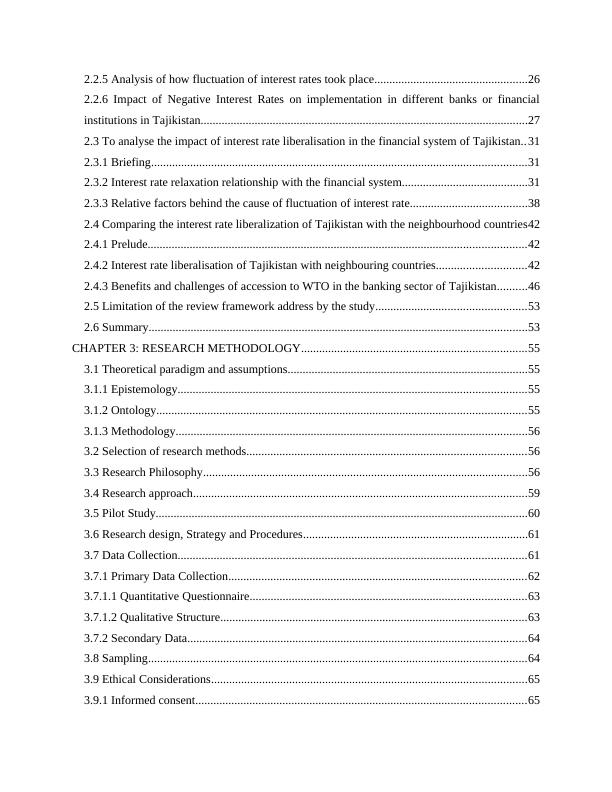
3.9.2 Privacy and confidentiality...............................................................................................65
3.10 Methodological Limitations..............................................................................................65
3.10.1 Reliability........................................................................................................................65
3.10.2 Validity...........................................................................................................................65
3.11 Limitations and Delimitation of Study..............................................................................66
3.12 Summary............................................................................................................................66
REFERENCES..............................................................................................................................68
3.10 Methodological Limitations..............................................................................................65
3.10.1 Reliability........................................................................................................................65
3.10.2 Validity...........................................................................................................................65
3.11 Limitations and Delimitation of Study..............................................................................66
3.12 Summary............................................................................................................................66
REFERENCES..............................................................................................................................68

CHAPTER 1 - INTRODUCTION
INTRODUCTION
Financial liberalisation is essential for the financial activities of the organisation.
Introduction chapter provides the background and rationale of the study so that relevant aims and
objectives can be developed. It also describes research hypotheses and brief analysis of research
methods will be done.
Background
Financial liberalisation should be understood as the removal of restrictions in the
activities of banks in provision of financial services, for example, in the provision of loans,
deposit registration, etc. This enables the financial institutions to decide independently on whom
and by what criteria to allocate loans, allows them to set the price (interest rate) for loans and
interests on received deposits, and determine where to (aside from lending) allocate the funds at
their disposal (Bogdan & Biklen, 2003). There is a close connection between liberalisation and
banking crisis, which deserves close attention.
In the 1990s, beneath the impact of economic complications a number of countries started
fundamental changes in monetary policy, institutional structure and overall performance of the
economy as well as in ways to accomplish the goals (Harrod, 2008). Due to the gradual
economic backlog, many countries in Latin America and Asia, as well as countries with
centralised planning, relatively quickly abandoned government intervention in the economy and
liberalised economic activity. The process of liberalisation also spread to the financial sector, and
first of all to banks that for a long time belonged to the most regulated spheres of
entrepreneurship, not only in developing countries but also in many developed countries.
Furthermost specialists settle that financial liberalisation in itself is a progressive change since it
allows you to direct the investments to the place where they can be used most effectively. Thus,
liberalisation helps to accelerate economic progression (Sneider & Larner, 2009). Nevertheless,
the knowledge of numerous countries illustrates that under certain circumstances it can produce a
growth in rates and risks for some period of time.
Financial liberalisation significantly changes the environment banking sector. With
liberalisation, there is a risk of a disruption in the normal operation of the banking sector due to a
combination of the consequences of banks' behaviour in a regulated environment accumulated
but not solved problems and incentives acting in a new liberal environment (Ponterotto, 2005).
INTRODUCTION
Financial liberalisation is essential for the financial activities of the organisation.
Introduction chapter provides the background and rationale of the study so that relevant aims and
objectives can be developed. It also describes research hypotheses and brief analysis of research
methods will be done.
Background
Financial liberalisation should be understood as the removal of restrictions in the
activities of banks in provision of financial services, for example, in the provision of loans,
deposit registration, etc. This enables the financial institutions to decide independently on whom
and by what criteria to allocate loans, allows them to set the price (interest rate) for loans and
interests on received deposits, and determine where to (aside from lending) allocate the funds at
their disposal (Bogdan & Biklen, 2003). There is a close connection between liberalisation and
banking crisis, which deserves close attention.
In the 1990s, beneath the impact of economic complications a number of countries started
fundamental changes in monetary policy, institutional structure and overall performance of the
economy as well as in ways to accomplish the goals (Harrod, 2008). Due to the gradual
economic backlog, many countries in Latin America and Asia, as well as countries with
centralised planning, relatively quickly abandoned government intervention in the economy and
liberalised economic activity. The process of liberalisation also spread to the financial sector, and
first of all to banks that for a long time belonged to the most regulated spheres of
entrepreneurship, not only in developing countries but also in many developed countries.
Furthermost specialists settle that financial liberalisation in itself is a progressive change since it
allows you to direct the investments to the place where they can be used most effectively. Thus,
liberalisation helps to accelerate economic progression (Sneider & Larner, 2009). Nevertheless,
the knowledge of numerous countries illustrates that under certain circumstances it can produce a
growth in rates and risks for some period of time.
Financial liberalisation significantly changes the environment banking sector. With
liberalisation, there is a risk of a disruption in the normal operation of the banking sector due to a
combination of the consequences of banks' behaviour in a regulated environment accumulated
but not solved problems and incentives acting in a new liberal environment (Ponterotto, 2005).
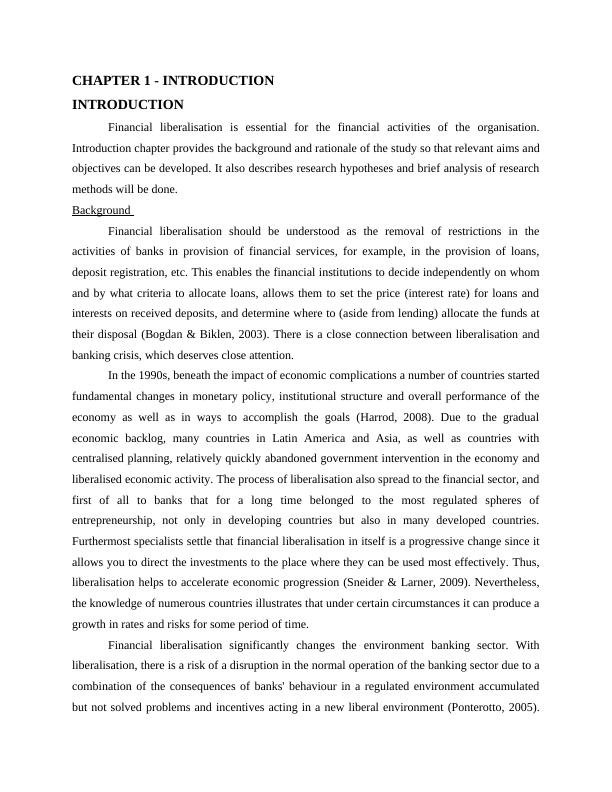
The environment, previously protected from external influences, together with strict regulation
of financial and credit activities, contributed to the development of negative phenomena in the
work of banks. In general, this means that decisions to place assets were made without taking
into account the market criteria for maximising profits. Often banks provided loans on the basis
of political requirements or subjective desire of owners, sometimes simultaneously acting as
customers of banking services. In such a situation, the banks were not formed, and the skills
necessary for successful functioning in an unprotected and poorly regulated environment created
as a result of financial liberalisation could not be formed.
The previous practice of granting loans created a threat of decreasing the quality of the
loan portfolio and, at the same time, did not allow bankers to monitor debtors promptly and
assess the degree of risk in lending (Harrod, 2008). Usually financial liberalisation is conceded
out within the framework of the global approach of macroeconomic balance, financial
liberalisation and structural modifications (Senhadji, 2000). As a result of overall liberalisation
the economic situation of many enterprises deteriorates and the total of resources used to repay
bank loans is reduced. In the course of reforms and the implementation of stabilisation plans
which are often related with financial liberalisation banks change the way monetary policy is
implemented. These policy changes significantly affect the rate of interest change. Also, the role
of direct delivery of credits among banks decreases and the meaning of indirect tools of
influence on fluidity in the economy such as operations in the open money market, accounting of
bills increases. Thus, in order to achieve the profitable targets banks often varies interest rate.
In the progression of macroeconomic stabilisation further restrictions on economic policy
are also introduced (Berg and Krueger, 2002). These modifications in turn decrease the
possibility for banks to appeal other resources, such as primarily loans from the central bank and
short term financial resources purchased in e-market. The costs of obtaining these assets are
increasing. These factors are primarily associated with the changing interest rates and thus
influences the profits and financing functions of the economy.
At the same time situation is complicated by the fact that debtor companies themselves
are feeling the needs of limiting economic and financial policies. As an outcome, the liquidity
crisis can provoke a wave of non-payments, as debtors lose the ability to fulfil their obligations.
(Cojocaru and et.al., 2016).
A side effect of successful stabilisation programs is a high level of market interest rates,
of financial and credit activities, contributed to the development of negative phenomena in the
work of banks. In general, this means that decisions to place assets were made without taking
into account the market criteria for maximising profits. Often banks provided loans on the basis
of political requirements or subjective desire of owners, sometimes simultaneously acting as
customers of banking services. In such a situation, the banks were not formed, and the skills
necessary for successful functioning in an unprotected and poorly regulated environment created
as a result of financial liberalisation could not be formed.
The previous practice of granting loans created a threat of decreasing the quality of the
loan portfolio and, at the same time, did not allow bankers to monitor debtors promptly and
assess the degree of risk in lending (Harrod, 2008). Usually financial liberalisation is conceded
out within the framework of the global approach of macroeconomic balance, financial
liberalisation and structural modifications (Senhadji, 2000). As a result of overall liberalisation
the economic situation of many enterprises deteriorates and the total of resources used to repay
bank loans is reduced. In the course of reforms and the implementation of stabilisation plans
which are often related with financial liberalisation banks change the way monetary policy is
implemented. These policy changes significantly affect the rate of interest change. Also, the role
of direct delivery of credits among banks decreases and the meaning of indirect tools of
influence on fluidity in the economy such as operations in the open money market, accounting of
bills increases. Thus, in order to achieve the profitable targets banks often varies interest rate.
In the progression of macroeconomic stabilisation further restrictions on economic policy
are also introduced (Berg and Krueger, 2002). These modifications in turn decrease the
possibility for banks to appeal other resources, such as primarily loans from the central bank and
short term financial resources purchased in e-market. The costs of obtaining these assets are
increasing. These factors are primarily associated with the changing interest rates and thus
influences the profits and financing functions of the economy.
At the same time situation is complicated by the fact that debtor companies themselves
are feeling the needs of limiting economic and financial policies. As an outcome, the liquidity
crisis can provoke a wave of non-payments, as debtors lose the ability to fulfil their obligations.
(Cojocaru and et.al., 2016).
A side effect of successful stabilisation programs is a high level of market interest rates,
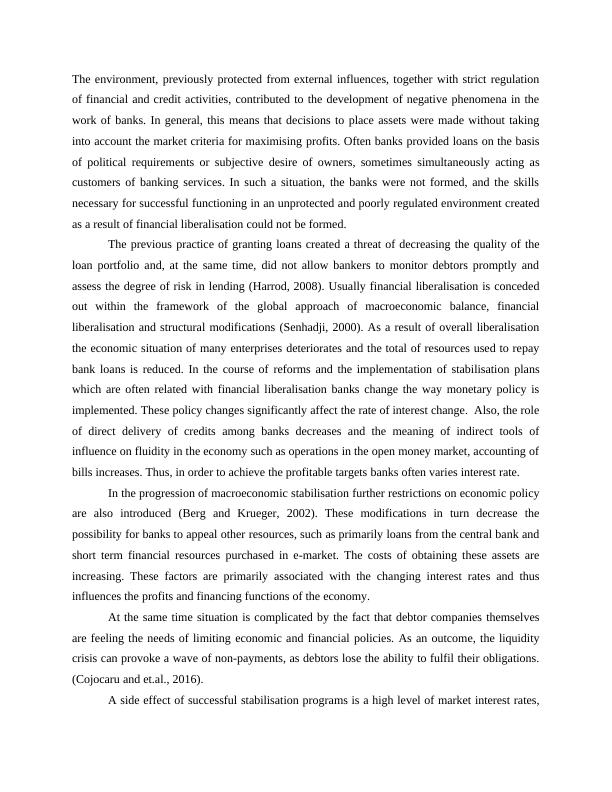
which is established, in particular, due to the accelerated inflation rate as compared to the
expected decrease, as well as the appreciation of the exchange rate. In the latter case, the
situation of enterprises that produce goods destined for export deteriorates, as their
competitiveness in the world market falls. Exporting enterprises in Tajikistan are forced to adjust
to the new condition increase efficiency, sales growth of products inside the country. Else, they
can face financial problems, which rises the risk for banks’ lending to these enterprises (Elsherif,
2016).
The interest rate has been one of the critical factor in encouraging the liberalisation
process within financial sector. When interest rates are increased it leads to increase refinancing
rate and thus banks have to pay higher cost to manage their resources. The increased interest
rates also affect debtors in negative manner. When such situations occurs in Tajikistan then,
investment projects promising high income despite increasing interest rates resort to commercial
banks (Fletcher, 2017)
Negative impact due to fluctuating economic policies and refinancing rate in Tajikistan is
changing the value of interest rates reliant on the loan reimbursement stage. In the course of
liberalisation, the differentiation among the interest rates short term and long term loans which is
of great meaning for banks usually decreases. In Tajikistan interest rates are differentiated on the
basis of loan terms. Hence, commercial banks of the country are able to generate profits by
transferring short-term liabilities (deposits) to long-term assets (loans) (Lane, 2018). Interest on
deposits mainly short-term through administrative limits was set at a much lower level than
interest rates on loans granted which usually issued for a long period. In a number of countries
such as UK and USA as a result of interest rate liberalisation, possibility of easy profit-making in
this way has diminished, as the cost of seeking financial resources has increased and it has suited
more problematic to establish high interest rates for the use of credit (Macit, 2017)
Banks are difficult to resist the negative impact on interest rates. Typically, bank liabilities
are sufficiently liquid, because they represent deposits that are not limited to a certain period, and
banks can quickly lose them. In contrast, assets have significantly less liquidity. Credit
obligations of borrowers, as a rule, can be sold to other entities only with large losses. The
severance of contractual credit relations, in turn, is associated with additional costs in the form of
penalties (Turk, 2016)
Financial liberalisation leads to increased competition between the banks. Therefore, they are
expected decrease, as well as the appreciation of the exchange rate. In the latter case, the
situation of enterprises that produce goods destined for export deteriorates, as their
competitiveness in the world market falls. Exporting enterprises in Tajikistan are forced to adjust
to the new condition increase efficiency, sales growth of products inside the country. Else, they
can face financial problems, which rises the risk for banks’ lending to these enterprises (Elsherif,
2016).
The interest rate has been one of the critical factor in encouraging the liberalisation
process within financial sector. When interest rates are increased it leads to increase refinancing
rate and thus banks have to pay higher cost to manage their resources. The increased interest
rates also affect debtors in negative manner. When such situations occurs in Tajikistan then,
investment projects promising high income despite increasing interest rates resort to commercial
banks (Fletcher, 2017)
Negative impact due to fluctuating economic policies and refinancing rate in Tajikistan is
changing the value of interest rates reliant on the loan reimbursement stage. In the course of
liberalisation, the differentiation among the interest rates short term and long term loans which is
of great meaning for banks usually decreases. In Tajikistan interest rates are differentiated on the
basis of loan terms. Hence, commercial banks of the country are able to generate profits by
transferring short-term liabilities (deposits) to long-term assets (loans) (Lane, 2018). Interest on
deposits mainly short-term through administrative limits was set at a much lower level than
interest rates on loans granted which usually issued for a long period. In a number of countries
such as UK and USA as a result of interest rate liberalisation, possibility of easy profit-making in
this way has diminished, as the cost of seeking financial resources has increased and it has suited
more problematic to establish high interest rates for the use of credit (Macit, 2017)
Banks are difficult to resist the negative impact on interest rates. Typically, bank liabilities
are sufficiently liquid, because they represent deposits that are not limited to a certain period, and
banks can quickly lose them. In contrast, assets have significantly less liquidity. Credit
obligations of borrowers, as a rule, can be sold to other entities only with large losses. The
severance of contractual credit relations, in turn, is associated with additional costs in the form of
penalties (Turk, 2016)
Financial liberalisation leads to increased competition between the banks. Therefore, they are
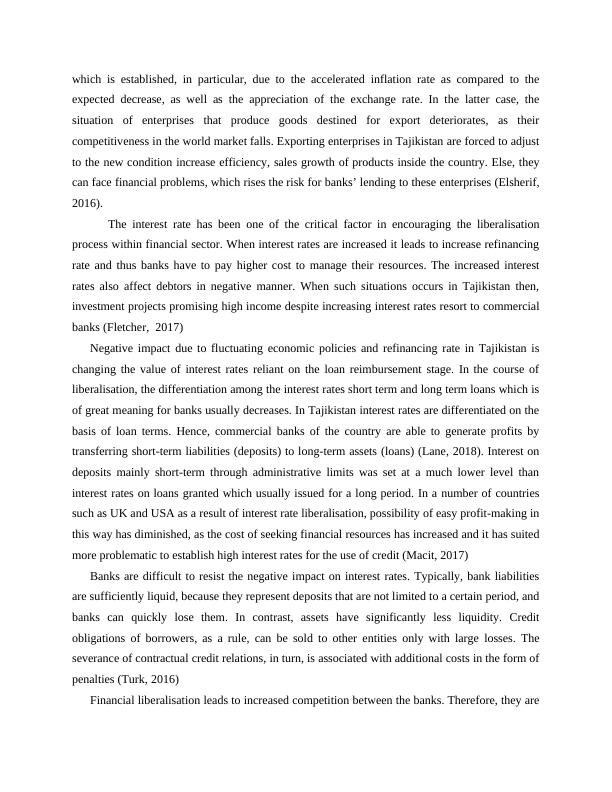
forced to both reduce the cost of finding resources, and to resist competitors in their use. As a
result, the profit decreases. liabilities of banks are affected by competition from other financial
institutions domestic and foreign that have access to the banking market. The situation of banks
is complicated by the fact that enterprises themselves can quickly inform about their financial
situation, which allows them to directly establish links with the owners of financial resources
without resorting to the help of banks. As a rule, enterprises that are able to seek non-bank
financing sources are the best customers and their loss means for banks increasing the level of
credit portfolio risk.
Research Problem
The main research gap that exists is the impact of interest rate on bank is highly impacting in
banking sector. But it has become difficult to identify that whether interest rate has changed due
to liberalization or not. So, this is the gap that exists. However, research done on it is not
sufficient to find out fluctuation in interest rate. Financial liberalisation is very difficult to
measure because economic fluctuations are beyond the control of any financial institutes. Hence
this has become the major issue in banking industry hence fluctuations of interest rate can not be
monitored and measured. (McKinnon and Shaw, 1973). Government of nation or finance
department of country has to keep close eye over interest rate fluctuations but it is very difficult
task that is affecting entire banking industry to great extent.
Aim& Objectives of the Research
Aim
To analyze impact of variation in interest rate in commercial banks in Tajikistan after
accession to the WTO. A case study on commercial banks of Tajikistan
Objectives
To determine relationship between interest rate and commercial banks in Tajikistan.
To examine with theory, models and analysis in order to investigate the fluctuation of
interest rate.
To analyse impact of interest rate liberalisation in financial system of Tajikistan.
To compare the interest rate and liberalisation of Tajikistan with its neighbouring nations.
result, the profit decreases. liabilities of banks are affected by competition from other financial
institutions domestic and foreign that have access to the banking market. The situation of banks
is complicated by the fact that enterprises themselves can quickly inform about their financial
situation, which allows them to directly establish links with the owners of financial resources
without resorting to the help of banks. As a rule, enterprises that are able to seek non-bank
financing sources are the best customers and their loss means for banks increasing the level of
credit portfolio risk.
Research Problem
The main research gap that exists is the impact of interest rate on bank is highly impacting in
banking sector. But it has become difficult to identify that whether interest rate has changed due
to liberalization or not. So, this is the gap that exists. However, research done on it is not
sufficient to find out fluctuation in interest rate. Financial liberalisation is very difficult to
measure because economic fluctuations are beyond the control of any financial institutes. Hence
this has become the major issue in banking industry hence fluctuations of interest rate can not be
monitored and measured. (McKinnon and Shaw, 1973). Government of nation or finance
department of country has to keep close eye over interest rate fluctuations but it is very difficult
task that is affecting entire banking industry to great extent.
Aim& Objectives of the Research
Aim
To analyze impact of variation in interest rate in commercial banks in Tajikistan after
accession to the WTO. A case study on commercial banks of Tajikistan
Objectives
To determine relationship between interest rate and commercial banks in Tajikistan.
To examine with theory, models and analysis in order to investigate the fluctuation of
interest rate.
To analyse impact of interest rate liberalisation in financial system of Tajikistan.
To compare the interest rate and liberalisation of Tajikistan with its neighbouring nations.
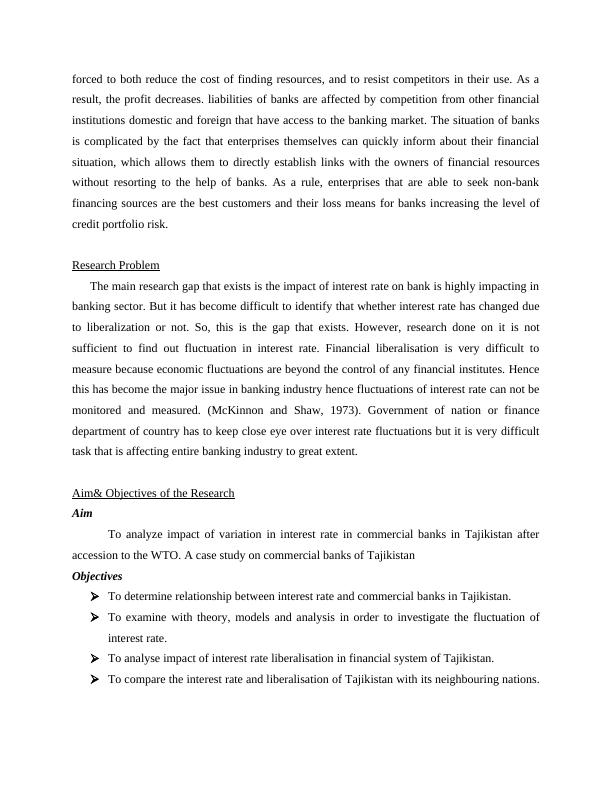
End of preview
Want to access all the pages? Upload your documents or become a member.
Related Documents
A National Emergency Preparedness Plan for Kuwaiti Community during Sand and Dust Stormslg...
|133
|46569
|52
Role of Microbusinesses in Poverty Eliminationlg...
|114
|32337
|96
Business Planning: Budgeted Statement Profit & Loss, Budgeted and Actual Balance Sheetlg...
|15
|2359
|1
Understanding Exponential Decay through Newton's Law of Coolinglg...
|9
|783
|478
Financial Analysis of a Factionary Companylg...
|21
|3118
|77
Impact of Corporate Social Responsibility on Brand Imagelg...
|79
|24669
|272
